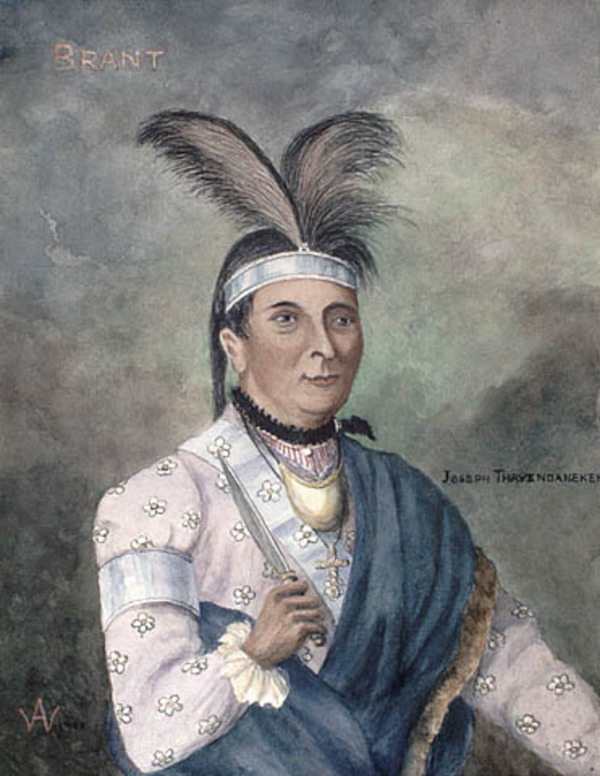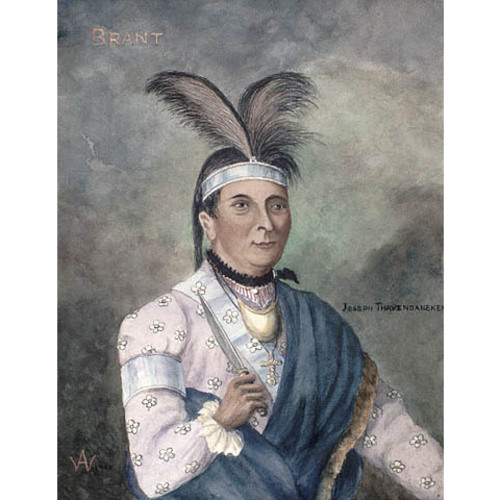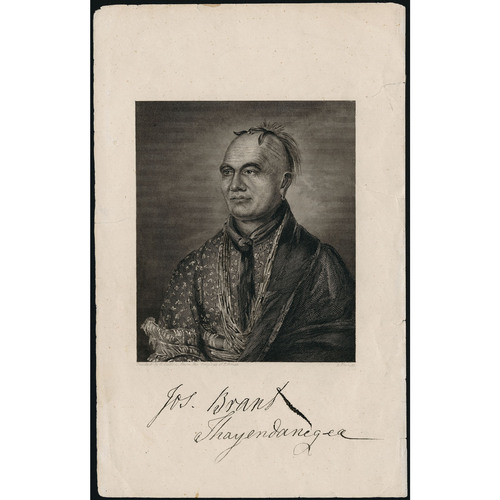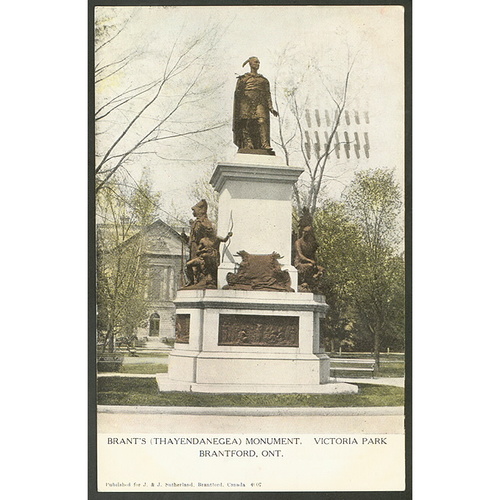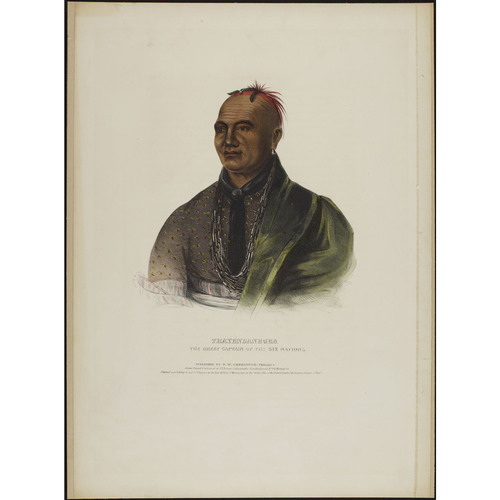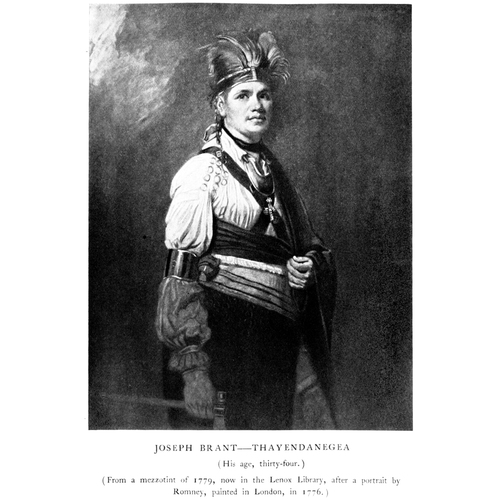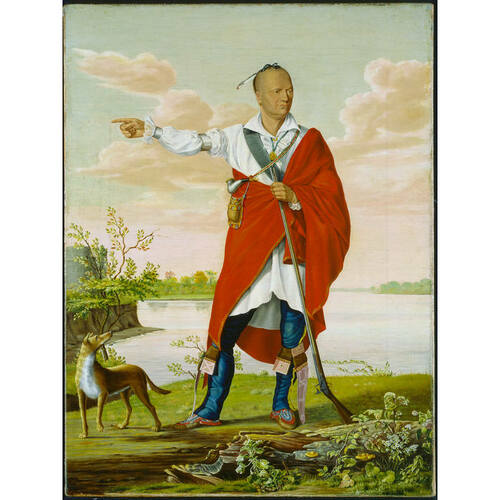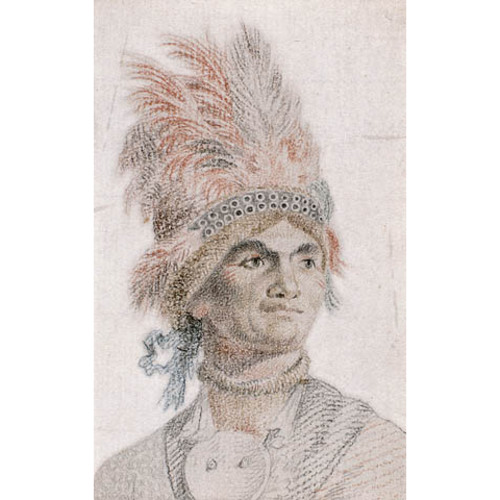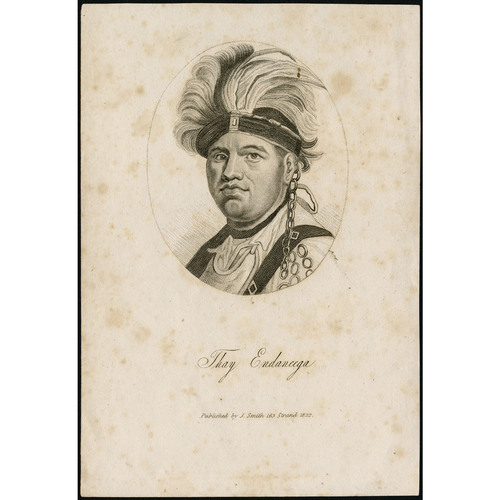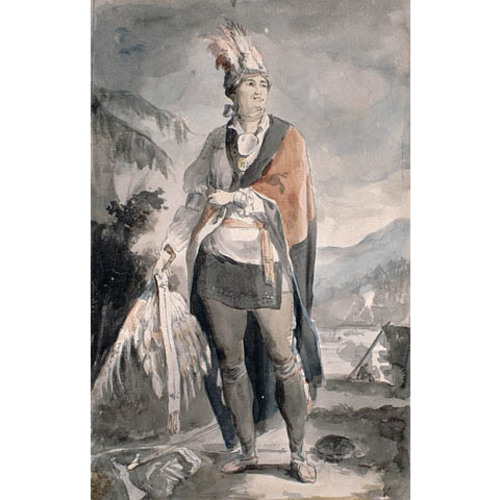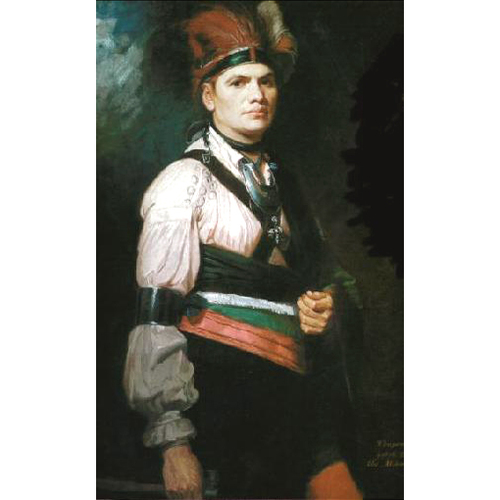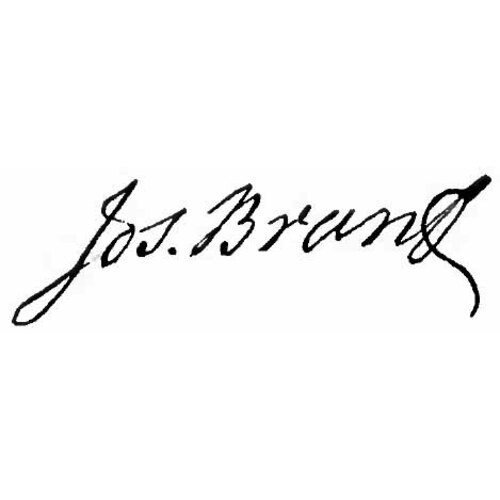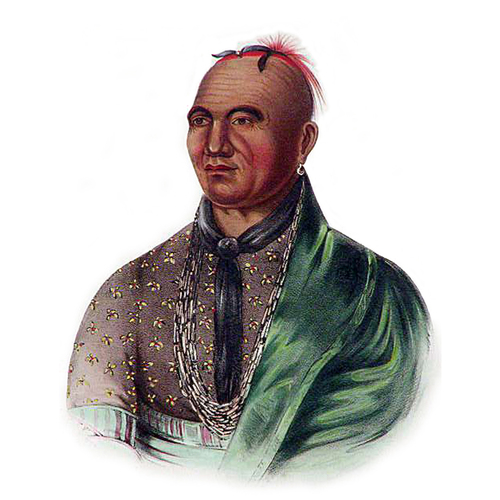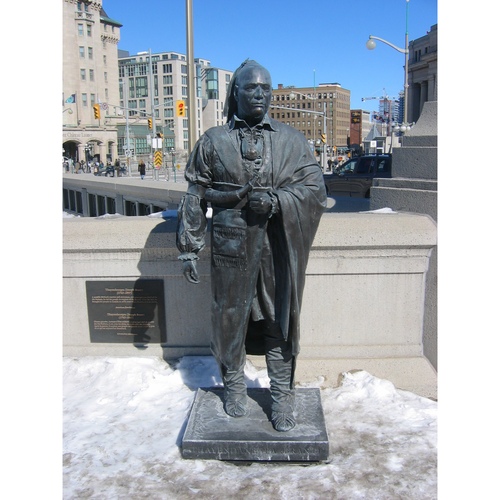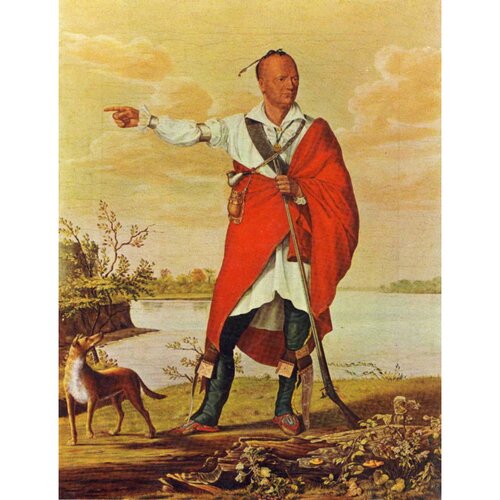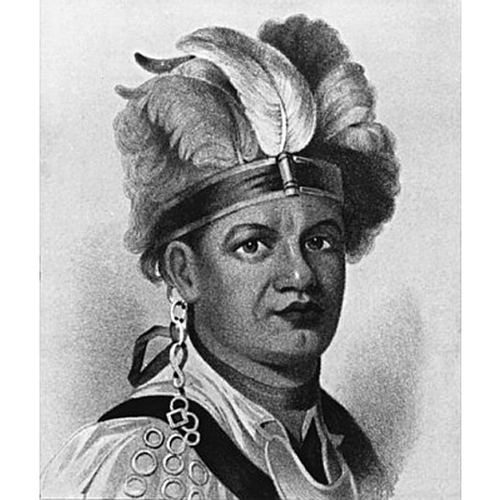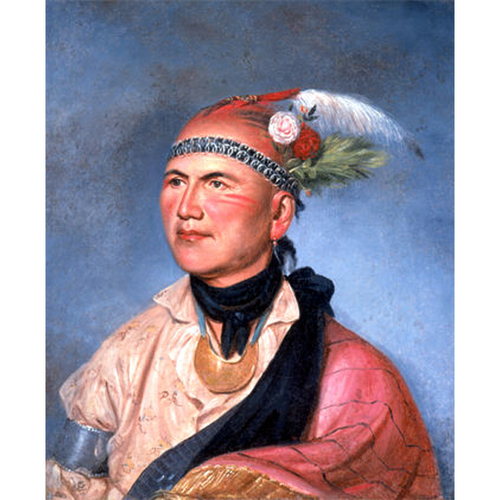THAYENDANEGEA (he also signed Thayendanegen, Thayeadanegea, Joseph Thayendanegea, and Joseph Brant), Mohawk interpreter, translator, war chief, and statesman; Indian Department officer; member of the wolf clan; his Mohawk name means he sets or places together two bets; probably b. c. March 1742/43 in Cayahoga (near Akron, Ohio), son of Tehowaghwengaraghkwin; d. 24 Nov. 1807 in what is now Burlington, Ont.
According to testimony Joseph Brant gave to John Norton*, he was “descended from Wyandot prisoners adopted by the Mohawks on both the father and mother’s side”; his grandmother had been captured when the Wyandots were living in the vicinity of the Bay of Quinte (Ont.). The tradition that the Mohawk chief Hendrick [Theyanoguin*] was an ancestor of Brant has been affirmed by historian Lyman Copeland Draper. In 1879 an elderly Mohawk woman named Katy Moses, who was a distant relative of Brant’s third wife, told Draper that Brant’s mother was descended from Hendrick. Charlotte Smith, née Brant, a granddaughter of Joseph, said that Brant’s mother was Hendrick’s granddaughter. When Brant visited England in 1775–76, he was interviewed at length by James Boswell, who wrote an account for the London Magazine of July 1776. In it Brant is called the grandson of the chief who visited England in the time of Queen Anne. But Mohawks use the term grandfather to refer also to great- and great-great-grandfathers and to great-uncles, and a chief named Brant (Sa Ga Yeath Qua Pieth Tow) who was also in the 1710 delegation may have been related to Joseph in some way.
Joseph was probably born in March 1742 of the Julian calendar. Estimates of his year of birth made by subtracting his age at death as given by his biographer William Leete Stone produce a date of 1743, but this purely arithmetical calculation ignores the change from Julian to Gregorian calendar which took place in his lifetime. Joseph’s father, Tehowaghwengaraghkwin, who was reputed to have been a prominent warrior, died while his son was an infant. A few years before the outbreak of the Seven Years’ War, Joseph’s mother took him and his sister Mary [Koñwatsiˀtsiaiéñni*] to the Mohawk valley, settling at Canajoharie (near Little Falls, N.Y.), which had been her home before the family’s emigration to the Ohio country. She married again, her new husband being a man named Carrihogo, or News Carrier, who was known to the whites as Barnet or Bernard, and by contraction, Brant. Young Joseph was called Brant’s Joseph and finally Joseph Brant. Author William Allen, who knew Joseph Brant’s son Joseph and possibly obtained the information from him, says that the stepfather, a chief, “was denominated an Onondaga Indian.” Stone, who interviewed various descendants, says that the stepfather was a Mohawk.
Brant’s first military service with the British came when he was about 15, during the Seven Years’ War. He took part in James Abercromby*’s campaign to invade Canada by way of Lake George (Lac Saint-Sacrement) in 1758 and he was with the warriors who accompanied Sir William Johnson*, superintendent of northern Indians, in the 1759 expedition against Fort Niagara (near Youngstown, N.Y.). The next year he was a member of the force led by Jeffery Amherst* that descended the St Lawrence to besiege Montreal.
Brant’s stepfather died about 1760. Testimony that Draper received from Brant’s godson, John “Smoke” Johnson*, indicates that a warrior known as Old Crooked Neck “took charge” of young Brant and brought him to Sir William Johnson. Impressed by his abilities, Johnson decided to send him to school. In the summer of 1761 Joseph was dispatched along with two other Mohawk boys to the Reverend Eleazar Wheelock in Lebanon (Columbia), Conn., to be enrolled in Moor’s Indian Charity School. Wheelock referred to him as “being of a Family of Distinction . . . , was considerably cloathed, Indian-fashion, and could speak a few Words of English.” His mental capacities and demeanour commended him highly to Wheelock. Brant was soon employed in teaching the Mohawk language to a fellow scholar, Samuel Kirkland, who planned to be a missionary to the Iroquois. On 4 Nov. 1761 Brant and Kirkland went to Iroquois country to secure six more boys for the school. They returned a few weeks later with two Mohawk boys and a promise from Johnson that he would send more when families had returned from the fall hunt.
So promising a student was Brant that Wheelock had planned to let him accompany Kirkland when he went on to the College of New Jersey (Princeton University); there Brant could continue tutoring the aspiring missionary in the Mohawk language while he himself studied in the local grammar school, perfecting his English and “pursuing other parts of Useful Learning perhaps fitting for College.” The plan did not materialize and in 1762 Kirkland went to the college alone.
Wheelock described Brant in February 1763 as being “of a Sprightly Genius, a manly and genteel Deportment, and of a Modest and benevolent Temper, I have Reason to think began truly to love our Lord Jesus Christ Several Months ago; and his religious Affections Seem Still agreeably increasing.” At this time Brant’s tutor, Charles Jeffry Smith, was making arrangements to take him with him to Mohawk country, where the two could continue to teach each other their respective languages and where Smith could serve as a missionary to the Mohawks. In May 1763, however, a letter came for Joseph from his sister Mary calling him home, since the Indians were displeased with his being at the school, “don’t like the People &c.” Wheelock begged Johnson’s indulgence for a few more months until Smith could be ready for his mission tour, and until Wheelock had had an opportunity to take Brant on a trip to Boston and Portsmouth, N.H., on school business.
Brant and Smith left for Mohawk country in the summer of 1763, and though both Smith and Wheelock looked forward to Brant’s return to the school, it was not to be. Johnson in fact was contemplating sending him to New York City where he could be prepared for entrance into King’s College (Columbia University). However, upon advice that prejudice against Indians was running high in the city as a result of Pontiac*’s uprising, Johnson sent him and three other Mohawk youths to missionary Cornelius Bennet in the Mohawk valley to further their education.
Along with other Iroquois allies of the British, Brant participated in the 1764 campaign against the Delaware Indian settlements on the Susquehanna River, and he was one of the volunteers on John Bradstreet*’s expedition against the western Indians that same year. His activities gave rise to the false rumour in New England that he had put himself at the head of a large party of Indians to attack the British. Though Wheelock’s confidence in Brant remained unshaken, the tale hurt his school financially. Wheelock later wrote that Brant had been “useful in the War; in which he behaved so much like the Christian and the Soldier, that he gained great Esteem.”
On 25 July 1765 Brant married an Oneida woman, Neggen Aoghyatonghsera, whose English name was Margaret, daughter of Isaac of Onoquaga. The ceremony was conducted at Canajoharie by missionary Theophilus Chamberlain*, who described the bride as “a handsome, sober, discreet & a religious young woman.” The Brants had two children, Isaac and Christiana, and lived in a comfortable house at Canajoharie where missionaries labouring among the Iroquois were always welcomed. Neggen contracted consumption and died, probably in mid March 1771. Brant then went to live with John Stuart, Anglican missionary at Fort Hunter, N.Y. He soon applied to Stuart to marry him to Neggen’s half-sister, Susanna. Stuart declined since the Church of England forbad such close kinship marriages, and Brant thereupon approached a German minister, who performed the ceremony. Susanna died after a brief time, leaving no issue. About 1779 Brant married Catharine [Ohtowaˀkéhson*], reputedly the daughter of former Indian agent George Croghan. She was from a prominent family and later became clan matron of the Mohawk turtle clan; her brother Henry [Tekarihó:ken*] was the tribe’s leading sachem. Seven children were born of this marriage: Joseph, Jacob, Margaret, Catharine, Mary, John [Ahyouwaeghs*], and Elizabeth. Brant sent Joseph and Jacob to the Wheelock family at Hanover, N.H., in 1800. Both Dartmouth College and Moor’s Indian Charity School were located there by this date, and the boys were entered in the school. It was John, however, who became prominent in Mohawk tribal affairs and in Upper Canadian politics.
During the time Brant spent with John Stuart, he had assisted the missionary in translating the Gospel of St Mark, a concise history of the Bible, and an exposition of the catechism into the Mohawk language. In Stuart’s estimation Brant was “perhaps . . . the only Person in America equal to such an undertaking.” Brant’s services and talents were also valued by Johnson, who used him as an interpreter and a translator of speeches into the languages of the Six Nations. Brant spoke at least three of these languages fluently. Norton states in his Journal that shortly before dying in 1774 Johnson used his influence with the Mohawks to have Brant chosen a chief, presumably a war chief, but that Brant accepted the honour with some hesitation. Brant also served Sir William’s successor, Guy Johnson*. In 1775 he received the appointment of “Interpreter for the Six Nations Language” at an annual salary of £85 3s. 4d., American army currency.
After the outbreak of hostilities in the Thirteen Colonies in 1775, Brant remained loyal to the king. He went to Montreal with Guy Johnson in the summer and in November embarked for England with Johnson, Christian Daniel Claus*, and a few associates to present their position on Indian affairs to the British government. Brant was generally lionized, introduced to some of the leading men in the arts, letters, and government, inducted into the Falcon Lodge of freemasons, and had his portrait painted. According to Boswell, he “was struck with the appearance of England in general; but he said he chiefly admired the ladies and the horses.” He did not, however, neglect the serious side of his mission. He and his Mohawk companion, Oteroughyanento (Ohrante), presented Iroquois grievances about encroachments on their lands to Lord George Germain, secretary of state for the American Colonies. “It is very hard when we have let the Kings subjects have so much of our lands for so little value, they should want to cheat us . . . of the small spots we have left for our women and children to live on,” Brant said. Germain fully agreed that the Indians had been wronged by the Americans but stated that the government could not attend to redressing these grievances until the dispute with the king’s rebellious subjects had been settled. He hoped that the Six Nations would remain loyal and could, as a consequence, be assured “of every Support England could render Them.” The promise satisfied Brant and he later repeated it in a speech to the Six Nations. Indeed, as a result of discussions with numerous English leaders of varying political persuasions, he became more firmly convinced than ever that the welfare of the Indian nations lay in a continuing alliance with the king.
Brant and his companions returned to North America in time to participate in the battle of Long Island in the summer of 1776. Then he and his loyalist friend Gilbert Tice went in disguise through the American-held countryside to Iroquois territory, where Brant urged the Indians to abandon their treaty of neutrality with the Continental Congress and actively support British arms. After persistent effort he eventually raised a force of about 300 Indian warriors and 100 white loyalists. For nearly a year he remained in the Susquehanna River region. Operating out of Onoquaga (near Binghamton, N.Y.), he made several excursions with his Indian-loyalist band to encourage white resistance, rouse the Indians, and confiscate food. In July 1777 he arrived at Oswego, followed by about 300 warriors, to join Barrimore Matthew St Leger*’s campaign. He participated in both the siege of Fort Stanwix (Rome) and the nearby battle of Oriskany that summer.
In January 1778 Brant left Fort Niagara with a party of warriors to reconnoitre in Indian country and be on the look-out for any American invasion attempt. In May and June his forces attacked Cobleskill and Durlach (Sharon). Again quartered at Onoquaga, he continued to send out foraging and scouting parties. Accompanied by a ranger detachment under Captain William Caldwell*, Brant and his warriors attacked and destroyed German Flats (near the mouth of West Canada Creek) in September. During October he and his men continued their raiding operations, mostly in Ulster County. He then joined forces with Captain Walter Butler*’s rangers and some Senecas for an attack on Cherry Valley early in November. During the course of events the Senecas detached themselves from Butler’s command and killed indiscriminately, friend and foe alike, throughout the settlement. Brant and his followers tried desperately, and with some success, to save numbers of white non-combatants from the fury of the Seneca warriors. According to every report, wrote Mason Bolton, commandant at Niagara, Brant “behaved with great humanity to all those who fell into his hands at Cherry Valley.”
During July 1779 Brant and his Indian-loyalist band attacked the settlement of Minisink (Port Jervis) and cut to pieces the militia sent in pursuit of them. On 29 August at the battle of Newtown (near Elmira), which was the major engagement of the Sullivan–Clinton expedition into Iroquois country, the Indians were less fortunate. A force of Indians, rangers, and a few regulars, commanded by Major John Butler*, Brant, Kaieñˀkwaahtoñ*, and Kaiũtwahˀkũ (Cornplanter), was defeated and obliged to retreat under the onslaught of the American army. The sheer number of the Americans and their superiority in weapons and supplies prevented any further full-scale confrontation for the remainder of the expedition, and the American invaders totally devastated the Indian country as far as the Genesee River before turning back. The Indian refugees were forced en masse into the area around Fort Niagara, straining British resources to the utmost.
Far from crushing the Six Nations, the invasion only increased their determination for revenge. Numerous raiding parties spread terror through the American frontier settlements during 1780. In the spring Brant and his band were raiding near Harpersfield, N.Y. In July they laid waste the villages of pro-American Oneidas and Tuscaroras. Brant was also with the Indians and loyalists who devastated the Mohawk valley settlements and the Schoharie region later that year.
Brant had been serving as a captain in the Indian Department at least since early 1779, although he did not have a commission. On 16 April 1779 Germain sent Governor Haldimand a commission signed by George III for Joseph Brant as colonel of Indians in appreciation of his “astonishing activity and success” in the king’s service. Haldimand suppressed the document, courteously explaining to Germain that Brant, despite his meritorious activity, was relatively young compared to the other Indian war leaders, “has been very lately known in the War Path,” and although distinguishing himself was as yet far from being recognized by the senior war chiefs as having an equal footing with the most experienced warriors of the confederacy. Such a mark of distinction, if it were presented to Brant, Haldimand warned, would therefore “be productive of very dangerous consequences” in stirring up jealousy and animosity towards him among the leading Iroquois warriors. Consequently Brant did not receive an official commission until 13 July 1780 when, on the recommendation of Guy Johnson, Haldimand made him a captain “of the Northern Confederate Indians.”
Despite his captaincy, Brant preferred to fight as a war chief. He later explained to Sir John Johnson* that that rank gave him command of more men in battle than was customary with a captain. The British officers who served with Brant and the commanding officers who received reports of his military behaviour always had the highest praise for him. He emerges in the official dispatches as the perfect soldier, possessed of remarkable physical stamina, courage under fire, and dedication to the cause, as an able and inspiring leader, and as a complete gentleman. White volunteers are known to have requested transfer from the rangers so that they could join Brant, “a person they had confidence in & had volunteerly served under with much satisfaction.”
In early 1781 Brant and John Deserontyon were planning to attack the Oneidas once more. Because of a rumoured invasion of the Ohio country by George Rogers Clark, however, Guy Johnson diverted Brant’s activities to that quarter. Brant and 17 warriors left Fort Niagara on 8 April 1781 for the Ohio Indian villages, where they remained several months encouraging the inhabitants. On 26 August Brant, with a hundred whites and Indians, utterly defeated an equal number of men from Clark’s army, killing or capturing all of them.
Brant’s final military service during the revolution came in 1782, when he and his warriors assisted Major John Ross*’s men in repairing Fort Oswego. Then, in July, he set out with a large party of warriors and a company of light infantry from the fort to harry the American settlements; he was summoned back, however, by Haldimand’s announcement of peace negotiations and the consequent recall of all war parties. Hostilities were drawing to a close, but Brant’s great career as a statesman was just beginning.
In the peace negotiations between Great Britain and the United States, Britain completely ignored its Indian allies and transferred sovereignty over all British-claimed land as far west as the Mississippi River to the Americans, even though almost the entire territory was occupied by Indians, who believed they had never relinquished it to the whites. When Brant learned of the treaty’s terms he angrily exclaimed that England had “sold the Indians to Congress.” The indignation of the Six Nations at their betrayal led the British administrators in Quebec to attempt to mollify them by various means. Sir John Johnson, superintendent general of Indian affairs, told them that “the right of Soil belongs to and is in yourselves as sole proprietors” beyond the boundary established by the 1768 Treaty of Fort Stanwix – a line running southwest from that fort to the Ohio River and thence to the Mississippi. Such statements about land title were bound to mislead Indians by obscuring the distinction between ownership of land and sovereignty over it. The British also maintained control of forts Oswegatchie (Ogdensburg, N.Y.), Oswego, Niagara, Detroit, and Michilimackinac (Mackinac Island, Mich.), all in ceded territory, and urged the formation of a confederation by the Iroquois and the Indians to the west. In addition, colonial officials appealed to the home government to secure a land grant within the province for the faithful Iroquois. Haldimand made arrangements for a tract on the Bay of Quinte to be provided for the Mohawks, who had lost all their land as a result of the war, and for other Six Nations Indians and their allies who cared to immigrate. The Senecas, however, objected to the location. They were the westernmost Iroquois tribe and their lands were not immediately threatened by the Americans. Most of them planned to stay where they were, and in their view a settlement on the Bay of Quinte would endanger the Six Nations by dispersing them over too great a distance. They offered the refugees instead a gift of land in the Genesee valley. Though the Mohawks refused the offer, Brant was persuaded that the Seneca reasoning had merit. Through him the Mohawks therefore requested of Haldimand a new grant closer to the traditional Six Nations homeland. In the autumn of 1784 they received a huge tract along the Grand River (Ont.), which the Mississauga Ojibwas had relinquished in May, and, with the exception of the Fort Hunter Mohawks under John Deserontyon who preferred to settle at the Bay of Quinte, they established themselves on this land. A census made in 1785 shows more than 400 Mohawks, several hundred Cayugas and Onondagas, and smaller groups of Senecas, Tuscaroras, Delawares, Nanticokes, Tutelos, Creeks, and Cherokees to a total of 1,843.
Brant played a major role in attempts to forge the Six Nations and the western Indians into a confederacy to oppose American expansion. In August and September 1783 he was present at unity meetings in the Detroit area and on 7 September at Lower Sandusky (Ohio) was a principal speaker at an Indian council attended by Wyandots, Delawares, Shawnees, Cherokees, Ojibwas, Ottawas, and Mingos. There he feelingly presented his grand vision: “We the Chief Warriors of the Six Nations with this Belt bind your Hearts and Minds with ours, that there may be never hereafter a Separation between us, let there be Peace or War, it shall never disunite us, for our Interests are alike, nor should anything ever be done but by the united Voice of us all, as we make but one with you.” The confederacy forged at these meetings would continue to be a principal concern of Brant’s for a number of years.
From 31 Aug. to 10 Sept. 1784 Brant was at Fort Stanwix for peace negotiations between the Six Nations and New York State officials, but he did not attend the treaty held at the same place with the commissioners of the Continental Congress in October. He did, however, express extreme indignation on learning that the commissioners had detained as hostages several prominent Six Nations leaders, including his friend Kanonraron (Aaron Hill). Brant delayed an intended trip to England attempting to secure their release.
In late 1785 Brant set sail to present Mohawk claims for war losses to the government, to petition for a half-pay pension, to request publication of religious literature in the Mohawk language, and to receive assurance that Indian land had not been given to the United States. Most important, he wished to ascertain whether the faithful Indian allies of the king might expect support from the British government should war break out between the Americans and the confederated Indians over American encroachment on Indian lands. He made the trip over the strong opposition of Sir John Johnson, who urged him to stay at home and attend to the affairs of the confederacy.
In England Brant succeeded in securing his pension and a compensation of about £15,000 for the Mohawks. As for his query whether the Indians would “be considered as His Majesty’s faithful allies, and have that support and countenance such as old and true friends expect” should “serious consequences” develop over American encroachments on Indian land, Brant received an assurance from Home Secretary Lord Sydney of the king’s continual concern for Indian welfare and a recommendation from the king that the Indians conduct their affairs “with temper and moderation” and a “peaceable demeanor,” all of which would “most likely . . . secure to themselves the possession of those rights and privileges which their ancestors have heretofore enjoyed.” It was obviously a polite refusal to become militarily involved in the Indians’ problems.
The Indian confederacy was not functioning as Brant had planned. The Americans had ignored it and had insisted on making treaties with smaller groups of Indians. The resulting treaties of Fort Stanwix (1784), Fort McIntosh (1785), and Fort Finney (1786), with their extortion of huge land grants, caused deep resentment, growing factionalism, and a disintegration of the unity Brant had sought to establish. He made trips to the Ohio–Detroit region in 1786, 1787, and 1788 to strengthen the confederacy and urge peace with the United States. He also tried hard to secure the Muskingum River (Ohio) as the boundary between the Indian nations and the United States, but such a settlement was not then acceptable to the American government.
The achievement of unanimity among the diverse Indian nations was one of the most difficult tasks undertaken by Brant and was never fully accomplished. His attempts to halt the treaties held by Major-General Arthur St Clair with the Indians at Fort Harmar (Marietta, Ohio) in 1789 were not successful; the American general conducted one with the Iroquois, exclusive of the Mohawks, and another with the Potawatomis, Sauks, Ottawas, Ojibwas, Wyandots, and Delawares. Predictably – St Clair’s policy was to divide and conquer – there was not a full representation even of the nations who were present. The policy led to Indian resentment and reprisals against white settlers and resulted in three full-scale American retaliatory invasions.
Brigadier-General Josiah Harmar’s punitive expedition against the Shawnee and Miami villages along the Miamis (Maumee) River in October 1790 was defeated and turned back. Both Governor General Lord Dorchester [Guy Carleton] and Sir John Johnson told Brant that they wished to effect a peace between the western Indians and the United States, but both men also persisted in deliberately deceiving him concerning the boundaries established by Great Britain and the United States in 1783. They assured him once again that the king had not really given away the Indian lands in the west to the Americans and that the boundary set at the Treaty of Fort Stanwix in 1768 was still in effect. The deception helped provide the British in Canada with an Indian buffer on their frontier and laid the blame for white expansion into the west solely on the Americans.
Brant went into the Indian country south of the Great Lakes in the spring of 1791 to continue his consultation with the western nations. In a council held at Detroit and attended by deputy Indian agent Alexander McKee* and representatives of the confederacy, the Indians agreed that the Muskingum River should be their eastern boundary and sent Brant and 12 other deputies to Quebec to inform the government of their decision. Brant wanted to learn if the British would back the Indians in obtaining recognition of their boundary. Dorchester assured the deputies that the king had not transferred their country to the Americans but he also emphasized that the government could not involve itself in any hostilities. The reluctance of Dorchester to commit the government militarily was a disappointment to Brant. The Americans in 1791 had held a treaty with that portion of the Six Nations living south of the Great Lakes and successfully neutralized them. A treaty with the powerful Cherokees farther to the south had also been concluded. These American diplomatic successes further undercut the strength of the western confederacy.
In November 1791, however, St Clair’s army was defeated by western Indian forces under Little Turtle [Michikinakoua] near the Miamis Towns (Fort Wayne, Ind.). Because of Brant’s prestige and great influence with the Indian nations, President George Washington and Secretary of War Henry Knox invited him to the seat of government at Philadelphia in 1792 to seek his good offices in effecting peace in the west. It was the first of several trips Brant would make to confer with American government officials on Indian business. Though he was firm during the visit in protecting the Indian interests and though he rejected the American offer to him of a large land grant and a pension, which he considered a bribe, he believed that a compromise could be worked out on the boundary question and he prepared to travel to the western confederacy in search of a peaceful solution. Because of a sudden sickness he arrived too late for the confederacy council held at the Glaize (Defiance, Ohio) from 30 September until early in October 1792, but he did have several unsuccessful consultations with the various Indian nations, who he now found had hardened their demands and were insisting on the Ohio River as a boundary. At a council between American commissioners and the confederacy Indians at Lower Sandusky in the summer of 1793, Brant had no more success in securing a compromise. Although the American commissioners were authorized to make some concessions so long as their existing settlements in the region could be maintained, the western Indians were adamant that the Ohio River should be the border and that all white settlements should be withdrawn. The failure of the negotiations made war inevitable and led in 1794 to the battle of Fallen Timbers (near Waterville, Ohio), where the western Indians were resoundingly defeated by Major-General Anthony Wayne’s army [see Weyapiersenwah].
After Wayne’s victory Brant and Lieutenant Governor John Graves Simcoe both went west in order to encourage the Indians to remain united. Brant promised them warriors from the Six Nations. These attempts to bolster the confederacy proved futile. The Treaty of Greenville conducted by Wayne in 1795 effectively spelled the end of the grand plan of Indian unity. Moreover, the onset of the French revolutionary wars in Europe had made Britain anxious for peace at any cost in North America. By Jay’s Treaty of 1794 she had agreed to surrender the border forts to the United States, and in 1796 these symbols of British support for the Indian cause were turned over to the Americans.
With the change in British policy, Brant’s persistence in encouraging Indian unity and in maintaining contacts with the other Indian nations became a source of annoyance and suspicion to the British government and to administrators such as Dorchester in the Canadas, who tried to keep the Indians divided, dependent, and subservient. Whereas they had once fostered an Indian confederacy and had encouraged Brant’s leadership, they now tried to discourage his diplomacy, undercut his influence, and redirect his activities to his own settlement. Brant was not one to be easily deterred, and the resulting controversy caused tension for many years.
At the Grand River Brant was the main spokesman. Though only a war chief, he served in the capacity of a sachem. He always worked closely with Tekarihó:ken, the leading Mohawk sachem, but it was to Brant that the chiefs entrusted their diplomacy and land negotiations because of his education, his fluency in English, his many contacts with government officials in England and Canada, and “his knowledge of the laws and customs of the white people.” His long association with the Johnson family and his familiarity with the upper classes in Great Britain and North America led him to adopt their manners. He lived in a genteel English style, had about 20 white and black servants, kept a well-stocked table, was waited on by black servants in full livery, and entertained graciously. In 1795 he secured a large tract of land from the Mississauga Indians in the vicinity of Burlington Bay (Hamilton Harbour), which purchase the government confirmed, and he subsequently moved into a fine house he built there. Whites who knew him socially expressed admiration for his intellect, his civility and amiable temperament, his dignity, and his ready wit. Physically impressive, he was 5 feet 11 inches tall, erect, powerful, and well formed, though tending to stoutness in his later years.
Brant had a continuing concern for the intellectual and spiritual advancement of his people. During the Revolutionary War he had obtained a schoolmaster for the Mohawk settlement near Fort Niagara and had a little log chapel built near present-day Lewiston, N.Y. After the immigration to the Grand River he helped secure a school, a schoolmaster, and a church, and by 1789 he had also translated a primer and the liturgy of the Church of England into the Mohawk language. He was planning to write a history for the Six Nations, but evidently, from the press of business, never began the project. He also attempted for a number of years to obtain a resident Anglican clergyman for the settlement and in 1797 turned his attention to Davenport Phelps, a son-in-law of Eleazar Wheelock, who was living in Upper Canada and practising law. He urged Phelps to apply for ordination so that he could serve the Grand River community. Both Peter Russell, administrator of Upper Canada, and Bishop Jacob Mountain* objected to Phelps because of his American military service and his alleged political views and activities. Brant carried on a lengthy correspondence with British officials on his behalf, but to no avail. Finally, through Brant’s urging, Phelps obtained his ordination in New York. He preached for a while near Burlington Bay but did not settle at the Grand River and soon returned to the United States. Brant’s considerable efforts to secure a resident minister for his people thus came to naught.
A tragic incident occurred in Brant’s family in 1795 during the annual distribution of government presents at Burlington Bay. Isaac Brant, who had a violent temper, attacked his father with a knife, wounding him in the hand as his father warded off the blow. Brant drew his dirk in self-defence and in the struggle inflicted a scalp wound on his son. Isaac refused medical attention, and in a few days the wound became badly infected and proved fatal. Brant turned himself in to the authorities but was exonerated. His role in his son’s death was a sorrow he bore for the remainder of his days.
A dispute that was to last for several years developed between the Mohawks of the Grand River and the Caughnawaga and St Regis Mohawks during the late 1790s. The latter, by the treaty of 31 May 1796 with the state of New York, abandoned their claim to an extensive area of land in the northern part of the state, the St Regis Indians agreeing to confine themselves to the boundaries of their present reservation along the St Lawrence River. The chiefs, including Atiatoharongwen, who negotiated the treaty later blamed Brant for the sale of their lands. The charge was completely unfounded and unjust. It arose out of a misunderstanding, a desire to shift the blame to another, or deliberate misrepresentation to the Caughnawaga and St Regis Indians on the part of Egbert Benson, the chief New York negotiator. It took Brant four years to secure the complete details of the negotiation from the Caughnawaga and St Regis Indians and from Albany officials, all of whom were reluctant to release information. Through painstaking search and interviews with most of the principals except Benson, who refused to cooperate, Brant was able to clear himself and the Grand River Mohawks.
Scarcely any problem was more enduring or more vexing to Brant than the controversy over the nature of the Six Nations’ title to the Grand River lands and the extent of the grant. According to the original Haldimand grant, a tract of approximately two million acres, from the source to the mouth of the river and six miles deep on each side, had been given to the loyalist Six Nations Indians. Later the government claimed that a mistake had been made in the original grant in that the northern portion had never been bought from the Mississaugas and the king accordingly could not grant what he had not bought. Despite repeated urgings by Brant and the other chiefs, the government never made the additional purchase. Brant also believed that the area along the Grand River was too large for the Indian population to farm and too small for hunting. With whites moving into the region in increasing numbers and more land being cleared, game was becoming scarce. He therefore wanted the community to realize a continuing income from the land by sales and leases to whites. Brant also strongly believed that whites living among them and intermarrying with them would bring and transmit skills needed by the Indians in a changing environment. Though Brant was firmly convinced that the land was, or should have been, granted to the Indians on the same basis as to the white loyalists, in fee simple, to do with as they wished, both Lord Dorchester and Lieutenant Governor Simcoe advanced the curious argument that the king’s allies could not have the king’s subjects as tenants. The Royal Proclamation of 1763, which had prohibited individual whites from purchasing Indians’ land in order to guard the Indians against fraud, was cited. Simcoe further emphasized that the Grand River grant was meant solely for Indians and was never to be alienated. Brant refused a title deed from Simcoe that forbad alienation. By 1796 Dorchester and Simcoe had finally relented to the extent of agreeing that Grand River lands might be leased, although the government would have the right of pre-emption; Brant continued to oppose any restriction of Indian sovereignty.
Brant’s leadership did not go unquestioned. Fort Hunter Mohawk Aaron Hill and his brother Isaac (Anoghsoktea) had complained to Lord Dorchester in 1788 about Brant’s policy of bringing whites among them. They also resented his growing political influence. Moreover, the land sales resulted in tangled finances because several of the purchasers were unable to keep up with their payments. Some Indians began to blame Brant for the financial mess and the lack of income from the sales. A few even believed he was pocketing the money. Indeed the tensions at the Grand River may have prompted Brant’s decision to move to Burlington Bay.
In order to secure for the Six Nations the right of complete control over their Grand River lands, Brant contemplated another trip to England to lay their grievances before the government. Lacking the funds for such an enterprise, he went instead in early 1797 to Philadelphia to relay his complaints to the British minister, Robert Liston. Brant’s strategy there was to talk openly about concluding an alliance with the French if his people were not better treated and to let the rumours drift back to Liston. In conference with Liston, he then rehearsed the whole history of the Six Nations’ troubles with the government and accused the authorities in the Canadas of refusing to sanction land sales by the Indians because they had personal designs on those same lands.
Brant deliberately associated with the pro-French party in the American capital and studiously avoided mixing with anyone from the administration, even ignoring the repeated invitations of Secretary of War James McHenry to call upon him. McHenry had arranged an appointment for him with Washington, but Brant departed Philadelphia without meeting the president and left behind many complaints that he had not been treated well by the American government officials. Liston’s description of Brant as “so determined, so able, and so artful” was apt.
Brant’s behaviour was alarming to both Liston and the British authorities in Canada. Rumours were rife of a Franco-Spanish attack on British possessions by way of the Mississippi, and it was feared that discontent among the Indians might lead them to join such an invasion [see Wabakinine*]. Thus in 1797, Brant, through extreme pressure on Peter Russell, received approval for the land dispositions already made. This was only a temporary respite, for the government continued in subsequent years to hold a totally negative attitude toward any Indian right to sell or lease lands to individuals.
Also in 1797 the Mohawks were successful in negotiating a settlement with New York State for the woodlands surrounding their former villages at Fort Hunter and Canajoharie. Brant and John Deserontyon held a treaty at Albany with New York State on 29 March 1797 by which the state awarded the Mohawks a modest compensation of $1,000 and $600 for expenses.
Brant was still determined to secure full Indian sovereignty over the Grand River lands, and he sent his associate John Norton to England in 1804 to present the Indian case and to get the original Haldimand grant confirmed. William Claus*, deputy superintendent general of Indian affairs in Upper Canada, reacted by attempting to manipulate Brant’s ouster as chief. Claus sent an Indian emissary, a Cayuga chief named Tsinonwanhonte, to the Grand River to undermine Brant and also wrote to officials in England in an effort to sabotage Norton’s mission. Not being able to persuade the great majority of Grand River Indians that Brant and Norton were corrupt and working against their interests, Claus sowed distrust among the Six Nations on the American side of the border. They called a Six Nations council at Buffalo Creek, despite the fact that the grand council fire of the Six Nations Confederacy had been moved several years before to the Onondaga village at the Grand River. This rump council, composed mostly of Senecas, disavowed Norton’s mission and deposed Brant as chief. Only a few people from the Grand River attended the meeting. A delegation from the Buffalo Creek council then went to Fort George (Niagara-on-the-Lake), Upper Canada, and held a similar council with Claus, who sent a copy of the proceedings to England and thereby effectively destroyed Norton’s mission. Brant later complained that Claus had dictated this document and that a number of the common folk had signed as chiefs to give the pronouncement more weight.
Brant fought back vigorously, berating in council those from the Grand River whom he charged with being Claus’s dupes. Then he went to Fort George and held a council on 28 July 1806 to accuse Claus of duplicity, reminding him that the Indians who chose to remain with the Americans had no equity in the Grand River lands and no say in their governance. The Grand River chiefs backed Brant fully and continued him in his chiefly office. He also received support from an anti-government faction that included William Weekes, judge Robert Thorpe*, and missionary Robert Addison*. He was planning another trip to England to plead the Indians’ cause and repair the damage Claus had done, but death claimed him.
Joseph Brant had been impressed by much in white culture. He admired the technology of the whites, their style of living, and their industry. He saw that in the changing circumstances in which Indians then lived, the traditional social structure of women farmers and men hunters would not suffice, for game was growing scarce and hunting accordingly declining. As a consequence, there soon would be more likelihood of hunger and only a reduced role in life for the Indian men. For Indians to survive, they would have to adopt white methods of agriculture, raising domestic animals and encouraging the men to become farmers. He invited white families to come and live by his people at Grand River “for the purposes of making roads, raising provisions and teaching us the benefits of agriculture.” Brant was furthermore convinced that one of the best means of helping his people through the transition was intermarriage with the whites. There were other features of white culture that Brant valued highly. He was a conscientious Anglican, translating portions of the Bible and helping to found churches for his people. He also saw the necessity of Indians becoming literate in their own language as well as in English and he diligently promoted education.
But there were aspects of white culture that Brant shunned, comparing them unfavourably with the less competitive, more egalitarian ways of the Iroquois. He was repelled by the deep-seated class divisions in white society, the harshness of its laws, the inequitable dispensing of justice, the suppression of the weak by the strong, the horror of the prisons, and the particularly shocking practice of imprisonment for debt. “The palaces and prisons among you form a most dreadful contrast,” he reminded a white correspondent. “Go to the former places, and you will see perhaps a deformed piece of earth assuming airs that become none but the Great Spirit above. Go to one of your prisons; here description utterly fails!” He was well aware that among whites the laws could often be manipulated or bypassed by the powerful and that “estates of widows and orphans” could be “devoured by enterprising sharpers” – a thing that never happened among Indians. These aspects of white culture Brant considered totally inconsistent with the teachings of Christianity. “Cease, then, to call yourselves Christians, lest you publish to the world your hypocrisy,” he admonished the same correspondent. And then he turned back upon the whites a favourite epithet of theirs that had always incensed the Indians: “Cease, too, to call other nations savage, when you are tenfold more the children of cruelty than they.”
The moral deficiencies in white society were not only an offence to Brant’s idealism. He saw them as practical obstacles that hindered his people from adopting the features of white civilization necessary for their survival. Writing to Samuel Kirkland in 1791 he explained: “A chain of corroborating circumstances, and events, seems to evince to them that the white people, under whatever pretence, aim at their destruction – possess’d with such Idea’s their prejudices naturally encrease and seeing the sword in one hand, supported by injustice and corruption, is it any wonder that they suspect the sincerity of any proposals made on the other hand for so great a change as civilization must make. . . .”
Brant was a noble figure who dedicated his whole life to the advancement of his people and who struggled to maintain their freedom and sovereignty. His major failure was his inability to understand the nature of British imperialism and to comprehend the fact that the British would not permit two sovereignties to exist in Upper Canada. The Indians were manipulated and exploited by the British government to serve the purposes of the empire; they were encouraged to cede their land in time of peace, pressured to become military allies in time of war, ignored in the treaty of peace, urged to form an enlarged confederacy as a barrier between the British and the Americans, and coerced to abandon the confederacy when the British had composed their differences with their enemy and growing Indian power threatened to rival their own. British colonial agents were then urged to foster jealousies and divisions among the Indian nations in order to keep them in a state of continual dependency upon the British government. Nor did Brant really understand how dependent the Indians had become in their new environment close to their white neighbours. Even land sales by the Six Nations, which Brant supported for immediately practical reasons, would eventually attach them irreparably to the surrounding white economy as Indian land holdings diminished. Only Brant’s larger vision of Indian unity, had it been achieved, would have succeeded in maintaining Indian sovereignty for a longer period and slowing white expansion. In this plan he was defeated by jealousies and divisiveness among the confederated Indian nations, and by American and then British successes in undermining the general confederacy. When Tecumseh revived the concept of a confederacy in the next generation, it was already too late.
[There are several portraits of Brant. At least two were made of him during his first visit to England in 1776. Of these, the well-known one by George Romney is in the National Gallery of Canada, Ottawa. Another was the work of an unknown artist commissioned by James Boswell and was reproduced in the London Magazine for July 1776. The Benjamin West study of Guy Johnson, painted in England in 1776, shows in the background an Indian often thought to be Brant. From the features, this supposition would seem unlikely. He may be either an idealized Indian or Oteroughyanento. During Brant’s second trip to England, in 1786, his portrait was painted twice by Gilbert Stuart. One work was commissioned by the Duke of Northumberland, an acquaintance from the American Revolutionary War, and is still in the private possession of the family at their home in Guildford. The second Stuart portrait, which has become as famous as the earlier Romney one, was commissioned by Francis Rawdon, another war-time acquaintance, and is now at the New York State Historical Association, Cooperstown. A copy is in the British Library. A miniature of this portrait was in the possession of the Brant family in the 19th century. Also during his 1786 visit, a portrait of him wearing the uniform of an officer of the Indian Department and Indian head-dress was painted by John Francis Rigaud. After Brant’s return to North America, the portrait was sent to him through the courtesy of Haldimand, who was living in England. The original seems to have disappeared, but a copy is in the New York State Education Department at Albany. There are four studies of Brant by William Berczy. The earliest, a water-colour bust portrait, was painted some time after 1794 and is in the Musée du Séminaire de Québec. Berczy made what seem to be two copies in oil of this water-colour, but slightly modified, being head to waist portraits, with the right hand resting on a tomahawk. Both are in private collections, in Montreal and Baltimore. Another Berczy, circa 1800, is a full-length portrait depicting Brant at the Grand River, and is in the National Gallery of Canada. While on a trip to Philadelphia in 1797, Brant sat for Charles Willson Peale. This painting is now in Independence Hall, Philadelphia. What was probably the last portrait of Brant was painted in Albany in 1805 or 1806 by Ezra Ames. A copy of it was made by George Catlin, and an engraving from the latter by A. Dick was printed as the frontispiece for the second volume of William Leete Stone’s biography of Brant. The Catlin copy, which hung in the New York State Library in Albany, was destroyed by fire in 1911. The original Ames portrait is now in Fenimore House, New York State Historical Association.
Brant’s house in Burlington was demolished in 1932. Construction of the present Joseph Brant Museum was begun in 1937 on land once owned by Brant. It contains the staircase and some other pieces of the original building.
In the 19th century, Brant’s papers were in the possession of his youngest daughter, Elizabeth Brant Kerr, and subsequently of her descendants. These papers were borrowed and many of them copied by Stone and Lyman Copeland Draper. Almost all the known Brant manuscripts, either published or unpublished, have been cited by M. J. Smith, “Joseph Brant, Mohawk statesman” (phd thesis, Univ. of Wis., Madison, 1946). A large amount of Brant correspondence is in BL, Add. mss 21661–892; PAC, MG 11, [CO 42] Q; MG 19, Fl and 176; and RG 10. The most extensive Brant collection in the United States is Draper mss, ser.F, held by the State Hist. Soc. of Wis. A number of Brant letters and speeches, some of them in Mohawk, are in the Burke Library, Hamilton and Kirkland Colleges (Clinton, N.Y.), Kirkland mss; NYPL, Philip Schuyler papers; N.Y. Hist. Soc. (New York), Henry O’Reilly coll. of docs. relating to the Five Nations and other Indians; and the Hist. Soc. of Pa. (Philadelphia), Indian records Coll. b.g.]
Additional sources used in the preparation of this article include: Dartmouth College Library (Hanover, N.H.),
William Allen, The American biographical dictionary . . . (3rd ed., Boston, 1857). “Calendar of state papers,” PAC Report, 1933: 87–88, 100. Handbook of American Indians (Hodge), 2: 741–42. Barbara Graymont, The Iroquois in the American revolution (Syracuse, N.Y., 1972). R. H. Kohn, Eagle and sword: the federalists and the creation of the military establishment in America, 1783–1802 (New York and London, 1975). W. H. Mohr, Federal Indian relations, 1774–1788 (Philadelphia, 1933). W. L. Stone, Life of Joseph Brant – Thayendanegea . . . (2v., New York, 1838). M. W. Hamilton, “Joseph Brant painted by Rigaud,” New York Hist. (Cooperstown, N.Y.), 40 (1959): 247–54; “Joseph Brant: ‘the most painted Indian,’” New York Hist., 39 (1958): 119–32. F. W. Hodge, “Some portraits of Thayendanegea,” Indian Notes (New York), 5 (1928): 207–17. C. M. Johnston, “Joseph Brant, the Grand River lands and the northwest crisis,” OH, 55 (1963): 267–82. E. H. Phillips, “Timothy Pickering at his best: Indian commissioner, 1790–1794,” Essex Institute, Hist. Coll. (Salem, Mass.), 102 (1966): 163–202. L. B. Richardson, “The Dartmouth Indians, 1800–1893,” Dartmouth Alumni Magazine (Hanover), 22 (1929–30): 524–27. G. J. Smith, “Capt. Joseph Brant’s status as a chief, and some of his descendants,” OH, 12 (1914): 89–101.
Cite This Article
Barbara Graymont, “THAYENDANEGEA (Thayendanegen, Thayeadanegea) (Joseph Thayendanegea, Joseph Brant),” in Dictionary of Canadian Biography, vol. 5, University of Toronto/Université Laval, 2003–, accessed July 10, 2025, https://www.biographi.ca/en/bio/thayendanegea_5E.html.
The citation above shows the format for footnotes and endnotes according to the Chicago manual of style (16th edition). Information to be used in other citation formats:
| Permalink: | https://www.biographi.ca/en/bio/thayendanegea_5E.html |
| Author of Article: | Barbara Graymont |
| Title of Article: | THAYENDANEGEA (Thayendanegen, Thayeadanegea) (Joseph Thayendanegea, Joseph Brant) |
| Publication Name: | Dictionary of Canadian Biography, vol. 5 |
| Publisher: | University of Toronto/Université Laval |
| Year of revision: | 1983 |
| Access Date: | July 10, 2025 |


